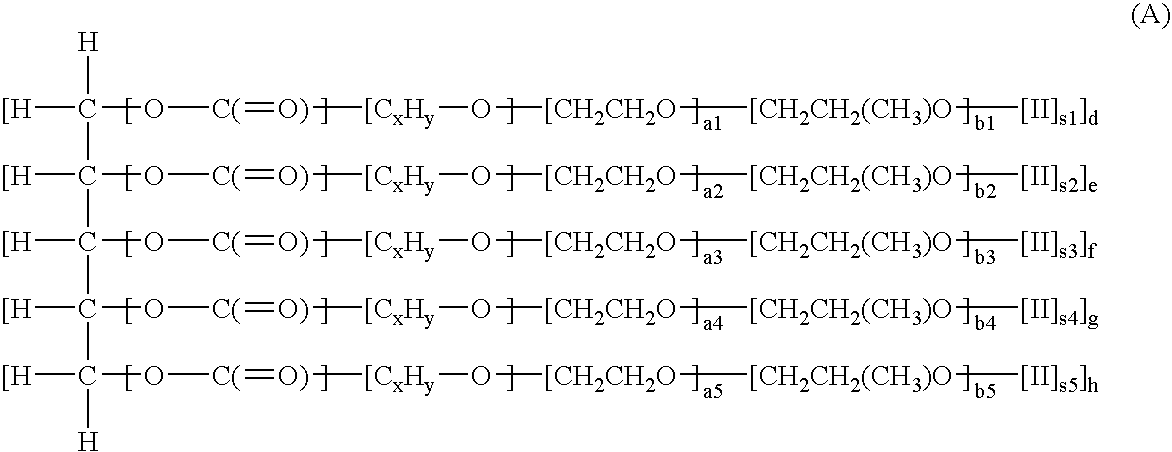[0032] Although water is a required carrier component, other vehicles may be admixed therewith if desired including alcohols and other easily evaporated solvents. However, it is most highly preferred to have a simplified composition of water as the sole carrier component in order to provide an
environmentally friendly formulation and to reduce the costs involved in producing such a composition.
[0046] The fabric softening compositions of the present invention include a liquid carrier, which is water and which may additionally contain up to 5% organic solvents such as lower alcohols selected from, for example, methyl
alcohol, ethyl
alcohol, isopropanol, and
butanol, or glycols, such as
propylene glycol,
diethylene glycol, and
hexylene glycol. Both the diluted and the concentrated versions of the product are preferably dispersions of the active ingredients in the water
solvent matrix. The organic solvents can improve handling, fluidity and
viscosity.
[0048] Various additives may be optionally employed in amounts of 0.1% to 30% in the conditioning compositions of the present invention which increase performance, formulation range and stability, or which aid in dispersibility,
viscosity control, and soil release. These include silicones, such as predominantly linear polydialkylsiloxanes, e.g., polydimethylsiloxanes; soil release polymers such as block copolymers of
polyethylene oxide and terephthalate fatty amines selected from the group consisting of primary fatty amines, secondary fatty amines,
tertiary fatty amines and mixtures thereof; amphoteric surfactants; smectite type inorganic clays; anionic soaps; zwitterionic quaternary
ammonium compounds and nonionic surfactants. Nonionic additives include fatty alcohols; linear, secondary, branched, olefinic, and
alkylphenol alcohol ethoxylates; mono- and di-glycerides; sorbitans; and
ion pairs of
anionic detergent surfactant and fatty amines. Cationic additives include monoalkyl trimethyl quaternary; ethoxylated amines; ethoxylated monoalkyl quaternary salts.
Polymer additives include
polyethylene oxide,
polypropylene oxide, terephthalate,
cyclodextrin, and
guar gum. Electrolytes may be added for
viscosity control in amounts of up to 5%, preferably in the range from 5 to 500 ppm. Such materials include Group IA and IIA halides, e.g., CaCl.sub.2, MgCl.sub.2 and NaCl, as well as alkylene polyammonium salts.
[0053] As noted above, this inventive composition and / or method provides improvements over typical cationic (quaternary ammonium) fabric softening agents. The lubricating abilities on fabrics accorded through utilization of the non-nitrogenated compounds noted above, surprisingly have been found to provide at least three highly desirable characteristics, namely, increased static dissipative capabilities, excellent softening levels, and decreased
surface friction measurements (for ease in ironing), for all different types of commonly used fibers (cotton,
polyester, nylon, blends, etc.). These benefits are apparent either when applied singly as an active fabric treatment agent during the rinse cycle of a standard
machine laundering process, or in the presence of quaternary ammonium softeners (to provide a synergistic improvement in each of these test areas over both types of compounds alone). Thus, the inventive compositions and methods provide, as shown below, a marked beneficial improvement within the fabric softening and treatment art to heretofore unattained levels.
[0054] Upon contact with the yarns and / or fibers of the target fabrics within the rinse cycle step, these compounds appear to, without intending to be bound to any specific
scientific theory, contact with and become adhered to the fibers and / or yarns themselves. Upon contact and adhesion, it appears that such components reduce the friction of the roughened, frayed, etc., fibers and / or fibrils. When dried, the heat applied to the target fabric then aids in melt-transporting these compounds over the target fabric. The free electrons present within the large amount of oxygens within the compound appears to aid in dissipating static electrical charges very effectively. Furthermore, the plasticization characteristics of the inventive softening additives provide highly effective softening benefits (i.e., a soft and pliable surface hand to the target fabrics) after application thereto comparable to that effectuated by standard quaternary ammoniums types. Additionally, the lubricating abilities of such compounds appears to aid in facilitating furthering ironing by permitting the
target fibers to become highly oriented as intended by the manufacturer, such that
surface friction is reduced thereby. The specific
fiber lubricants / plasticizers do not appear to easily evaporate or otherwise leave the fabric,
yarn, and / or
fiber surface, and therefore remains attached thereto providing effective
yarn friction reduction over the duration of such contact and adhesion to impart the desired
surface friction reduction over an appreciable amount of time, all without contributing a greasy or otherwise undesirable feel to the target fabric surface. Thus, such a simple, cost-effective, easy-to-use,
environmentally friendly, composition is a significant improvement in this industry, particular when it synergistically functions in combination with typical quaternary ammonium fabric softening compounds as well.
[0055] The term "rinse cycle" is intended to encompass the application of such compositions to target fabrics within, as noted throughout above, a standard mechanical rotary fabric washing machine, specifically during the cycle known as the rinse cycle [e.g., after washing through vigorous rotary movement of target fabrics in the presence of a detergent in order to remove excess high pH (potentially
skin irritating) detergent from the wash basin and / or to wash residual high pH detergent from the target fabrics themselves]. Thus, the inventive method requires addition of the compositions above (either the non-nitrogenated compounds, above, alone or in the presence of quaternary ammonium softening agents) to such a wash step during a standard mechanical laundering process. In such a manner, the liquid compositions may be most effectively applied to the target fabrics in order to accord the highest level of beneficial static reduction, surface
friction reduction, and softening increases.
 Login to View More
Login to View More 


